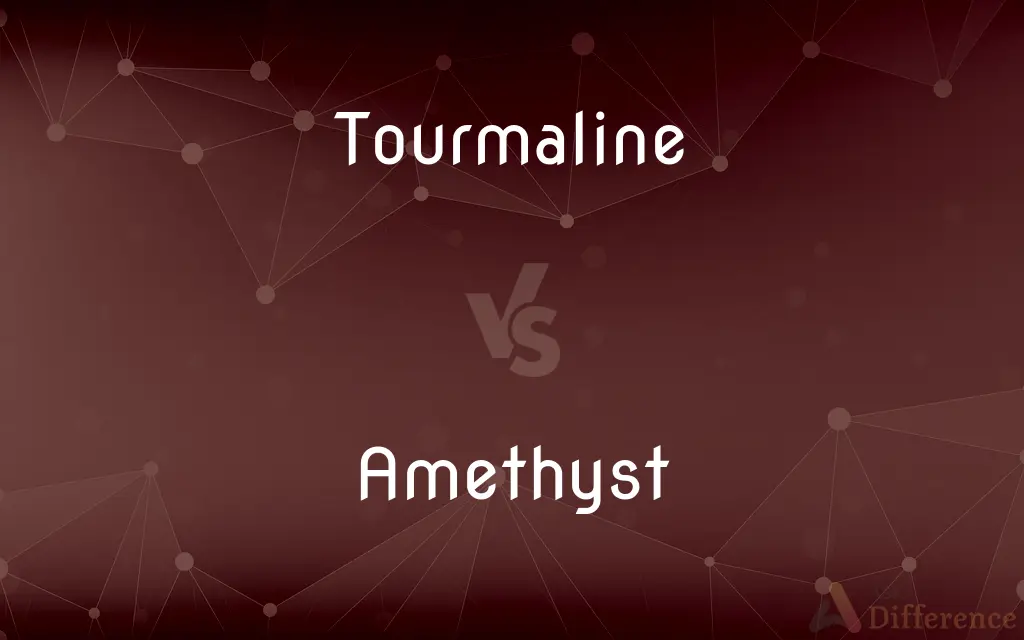Tourmaline vs. Amethyst — What's the Difference?
By Fiza Rafique & Maham Liaqat — Updated on March 10, 2024
Tourmaline is a complex borosilicate mineral with varying colors due to different metal ions, while amethyst, a type of quartz, is prized for its purple hues, caused by iron impurities and irradiation.

Difference Between Tourmaline and Amethyst
Table of Contents
ADVERTISEMENT
Key Differences
Tourmaline stands out for its wide color range, from black and brown to vivid reds, greens, and blues, attributed to various metal ions within its crystal structure. On the other hand, amethyst is consistently purple, ranging from light lavender to deep violet, primarily because of iron impurities and the impact of natural irradiation.
Tourmaline's crystal structure is trigonal, making it unique among minerals, which contributes to its diverse physical properties and appearance. Whereas amethyst, also with a trigonal crystal system, tends to have a more uniform appearance with its well-defined prismatic crystals and pyramid-like terminations.
The presence of water molecules in tourmaline's structure can cause it to exhibit piezoelectric and pyroelectric properties, meaning it can generate an electric charge under pressure or temperature changes. Amethyst does not share these properties, making tourmaline particularly interesting for scientific and metaphysical uses.
Tourmaline is often valued for its rarity and the unique property of pleochroism, displaying different colors when viewed from different angles. While amethyst, widely available and valued for its beauty, lacks this optical characteristic but is highly sought after for jewelry and decorative purposes.
The healing and metaphysical properties attributed to these stones also differ significantly. Tourmaline is believed to offer protective and grounding energies, varying by its color. Amethyst is thought to promote clarity of mind, sobriety, and help in overcoming addiction, showcasing how cultural and metaphysical beliefs vary between these two minerals.
ADVERTISEMENT
Comparison Chart
Color Range
Extremely varied, from black to bluish-green, red, and more
Primarily purple, from light lavender to deep violet
Crystal Structure
Trigonal, complex borosilicate
Trigonal, a form of silicon dioxide
Metaphysical Properties
Believed to offer protection and grounding, varies by color
Associated with clarity of mind and sobriety
Electrical Properties
Exhibits piezoelectric and pyroelectric properties
None
Availability and Use
Rare and used in high-end jewelry and for scientific purposes
Widely available and popular in jewelry and decorative items
Compare with Definitions
Tourmaline
A borosilicate mineral group known for its wide color range.
Black tourmaline is often used for protective jewelry.
Amethyst
A type of quartz known for its vibrant purple color.
Amethyst jewelry is popular for its beautiful violet hue.
Tourmaline
Each color of tourmaline is thought to have different metaphysical properties.
Pink tourmaline is believed to promote love and compassion.
Amethyst
Amethyst is the birthstone for February.
Amethyst rings are a common birthday gift for those born in February.
Tourmaline
Can display pleochroism, showing different colors from different angles.
A tourmaline crystal may appear red from one angle and clear from another.
Amethyst
Believed to promote clarity of mind and sobriety.
Amethyst is sometimes called the sobriety stone.
Tourmaline
Rare and valuable, especially the paraíba tourmaline.
The bright blue or green paraíba tourmaline is highly prized in fine jewelry.
Amethyst
Widely used in jewelry and as decorative items.
Large amethyst geodes are often displayed as art.
Tourmaline
Tourmaline exhibits piezoelectricity and pyroelectricity.
Some electronic devices utilize tourmaline for its electrical properties.
Amethyst
Its purple color is due to iron impurities and irradiation.
The depth of an amethyst's color can vary based on its iron content.
Tourmaline
Tourmaline ( TOOR-mə-lin, -leen) is a crystalline boron silicate mineral compounded with elements such as aluminium, iron, magnesium, sodium, lithium, or potassium. Tourmaline is classified as a semi-precious stone.
Amethyst
Amethyst is a violet variety of quartz. The name comes from the Koine Greek αμέθυστος amethystos from α- a-, "not" and μεθύσκω (Ancient Greek) methysko / μεθώ metho (Modern Greek), "intoxicate", a reference to the belief that the stone protected its owner from drunkenness.
Tourmaline
A complex crystalline silicate containing aluminum, boron, and other elements, used in electronic instrumentation and, especially in its green, clear, and blue varieties, as a gemstone.
Amethyst
A precious stone consisting of a violet or purple variety of quartz
Amethyst earrings
A delicate necklace of amethysts and pearls
Tourmaline
(mineral) A complex black or dark-coloured borosilicate mineral, compounded with various chemical elements and considered a semi-precious stone.
Amethyst
A purple or violet form of transparent quartz used as a gemstone.
Tourmaline
A transparent gemstone cut from it.
Amethyst
A purple variety of corundum used as a gemstone.
Tourmaline
A mineral occurring usually in three-sided or six-sided prisms terminated by rhombohedral or scalenohedral planes. Black tourmaline (schorl) is the most common variety, but there are also other varieties, as the blue (indicolite), red (rubellite), also green, brown, and white. The red and green varieties when transparent are valued as jewels.
Amethyst
A moderate purple to grayish reddish purple.
Tourmaline
A mineral that is a complex borosilicate and hydroxide of aluminum containing iron and magnesium and calcium and lithium and sodium; it is usually black but occurs in transparent colored forms that are used as gemstones
Amethyst
A transparent purple variety of quartz, used as a gemstone.
Amethyst
(uncountable) A purple colour.
Amethyst
(tincture) The tincture purpure, when emblazoning the arms of the English nobility.
Amethyst
Having a colour similar to that of the gemstone
Amethyst
A variety of crystallized quartz, of a purple or bluish violet color, of different shades. It is much used as a jeweler's stone.
Amethyst
A purple color in a nobleman's escutcheon, or coat of arms.
Amethyst
A transparent purple variety of quartz; used as a gemstone
Amethyst
Of a moderate purple color
Common Curiosities
Which is more valuable, tourmaline or amethyst?
Tourmaline, especially rare colors like paraíba, can be more valuable than amethyst.
Do tourmaline and amethyst have any industrial uses?
Tourmaline has unique electrical properties useful in some industries, while amethyst is primarily decorative.
What causes the color variation in tourmaline?
Different metal ions within its structure cause tourmaline's wide color range.
How are tourmaline and amethyst used in metaphysical practices?
Tourmaline is used for protection and grounding, while amethyst is believed to aid in clarity and sobriety.
Are there any famous historical pieces made with these stones?
Both have been used historically in royal and significant cultural artifacts, with amethyst being particularly popular in ancient times.
Why is amethyst purple?
Amethyst's purple color comes from iron impurities and the effects of natural irradiation.
What are the piezoelectric and pyroelectric properties of tourmaline?
These properties allow tourmaline to generate an electric charge when heated or put under pressure.
Can tourmaline and amethyst be found together?
While both can occur in similar geological environments, they are usually found separately.
Are there synthetic versions of these minerals?
Yes, both tourmaline and amethyst can be synthetically produced for jewelry and industrial purposes.
Can the color of these stones fade over time?
Amethyst can fade if exposed to direct sunlight for prolonged periods, while tourmaline is more color-stable.
Can the quality of these stones vary significantly?
Yes, factors like color intensity, clarity, and cut can greatly affect the quality and value of both tourmaline and amethyst.
How should tourmaline and amethyst be cared for?
Both should be cleaned with gentle soap and water, avoiding harsh chemicals and extreme temperatures.
Is there a difference in the hardness of tourmaline and amethyst?
Both have similar hardness levels on the Mohs scale, making them durable for jewelry use.
What is pleochroism, as seen in tourmaline?
Pleochroism is the ability to show different colors or intensities from different angles.
How does the availability of tourmaline and amethyst affect their price?
Amethyst's wider availability makes it generally less expensive than rare tourmaline colors.
Share Your Discovery

Previous Comparison
Inspire vs. Empower
Next Comparison
Cleanliness vs. OrderlinessAuthor Spotlight
Written by
Fiza RafiqueFiza Rafique is a skilled content writer at AskDifference.com, where she meticulously refines and enhances written pieces. Drawing from her vast editorial expertise, Fiza ensures clarity, accuracy, and precision in every article. Passionate about language, she continually seeks to elevate the quality of content for readers worldwide.
Co-written by
Maham Liaqat















































